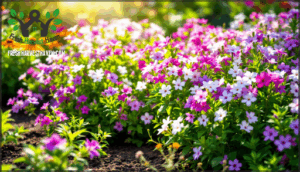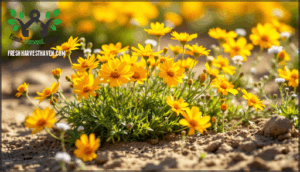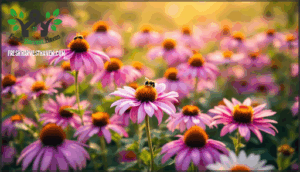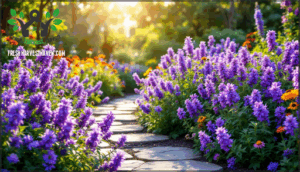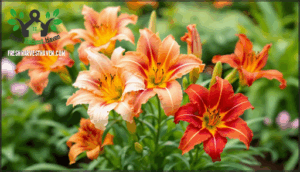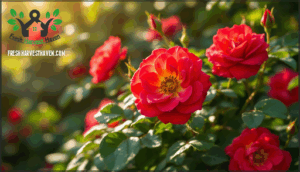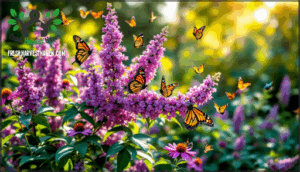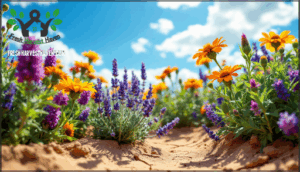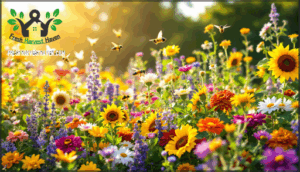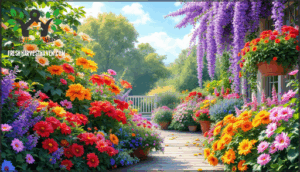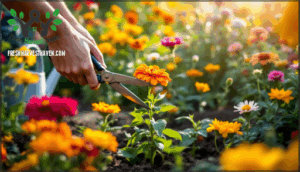This site is supported by our readers. We may earn a commission, at no cost to you, if you purchase through links.
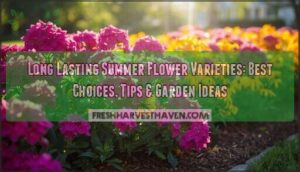
Garden Phlox pumps out fragrant blooms for eight solid weeks. Coreopsis keeps producing cheerful yellow daisies until frost if you deadhead spent flowers. These workhorses anchor your beds while annuals come and go. The right selections slash maintenance time and stretch your budget across multiple seasons.
You’ll discover which varieties thrive in full sun, tolerate drought, attract pollinators, and adapt to containers—plus the techniques that coax maximum bloom from each plant.
Table Of Contents
Key Takeaways
- Perennials like garden phlox, coreopsis, and coneflowers deliver eight to twelve weeks of continuous blooms from June through September, eliminating the need for constant replanting and reducing both maintenance time and long-term costs.
- Drought-tolerant varieties such as anise hyssop, red valerian, and yellow corydalis thrive in dry conditions with minimal watering, making them ideal for water-conscious gardeners or areas prone to heat waves.
- Pollinator-friendly flowers like bee balm, salvia, and black-eyed susan attract bees, butterflies, and hummingbirds while providing sustained nectar sources throughout the summer, with some species increasing pollinator visits by up to 30%.
- Maximizing bloom duration requires strategic deadheading, proper soil preparation with organic amendments, and selecting disease-resistant cultivars that can reduce fungicide needs by over 50%.
Best Long Lasting Summer Perennial Flowers
If you want color that sticks around all summer, perennial flowers are your best bet. These reliable bloomers keep gardens lively through the hottest months.
Here are some top choices for lasting summer displays.
Garden Phlox
Garden Phlox is a classic choice among summer blooming perennial flowers. You’ll see clusters of five-petaled blooms, thriving in loamy, moist soil with strong disease resistance. With a decades-long clump lifespan, it’s easy to propagate and pairs well with companion plants.
Many gardeners also find success with Coneflowers for summer. Explore phlox varieties for color diversity and focus on attentive flower care for lasting summer displays.
Coreopsis
If you’re searching for long blooming perennials, Coreopsis deserves your attention. These summer blooming flowers thrive in full sun and slightly acidic, sandy soil. Coreopsis varieties offer golden blooms and attract pollinators, making them excellent companion plants.
Propagation methods are straightforward—divide clumps in spring. Watch for powdery mildew, but otherwise, Coreopsis is a reliable perennial flower for any summer garden.
Consider planting bright yellow Achillea for a similar effect.
Coneflower (Echinacea)
Coneflower, known as Echinacea, stands out among summer blooming flowers for its long-lasting color and sturdy habit. You’ll find Echinacea varieties with pink, purple, or white petals, each attracting pollinators and birds.
Many gardeners value its medicinal uses, too. As a companion plant, Coneflower thrives with simple propagation methods and benefits from winter care to guarantee strong perennial flowers year after year.
Catmint
Shifting from Echinacea’s bold display, Catmint varieties offer a softer touch in the summer garden. Their fragrant purple blooms attract bees and butterflies, making them pollinator friendly and excellent companion plants.
Pruning catmint after flowering encourages rebloom, while simple catmint propagation keeps your beds full. Drought tolerant plants like these add reliable color and aromatic uses all season.
Daylily
Few perennial flowers match the stamina of the daylily. Hybrid daylilies and reblooming varieties keep your summer garden lively for weeks, especially with deadheading. You’ll find daylily colors from soft peach to fiery red, making them excellent companion plants. Everblooming daylilies are resilient, though watch for daylily pests in loamy, acidic soil.
- Wide color palette
- Minimal care needed
- Thrives in loamy, acidic soil
- Reblooming habits extend display
- Pairs well with other perennials
Knock Out Rose
A true workhorse in summer gardening, the Knock Out Rose delivers non-stop blooms even in partial sun. Disease resistance sets it apart from fussier rose varieties, so you won’t spend your afternoons battling mildew. Pruning methods are simple, and the bloom cycles are reliable.
Here’s a quick look:
| Sun Requirements | Pruning Methods | Bloom Cycles |
|---|---|---|
| Partial-Full | Annual Cutback | Continuous |
Butterfly Bush
With its fragrant, nectar-rich blooms, Butterfly Bush is a magnet for pollinators in any summer garden. Buddleja varieties thrive with basic Butterfly Bush Care—just regular deadheading and mindful Pruning Techniques.
Pair with companion plants like coneflowers for vibrant, butterfly-friendly gardens.
Watch for invasive potential in some regions, especially when designing pollinator-friendly perennial flowers for your summer garden.
Drought-Tolerant Summer Bloomers
If your garden faces dry spells or you want flowers that don’t need much fuss, drought-tolerant summer bloomers are a smart choice. These hardy plants keep their color and charm even when rain is scarce.
Here are some top picks for a resilient summer display.
Anise Hyssop
Ever wondered which perennial flowers can thrive when summer turns dry? Anise Hyssop stands out for drought resistance and fragrant foliage. Its 8–10 week bloom draws pollinators, making it ideal for pollinator-friendly gardens. You can use it for companion planting and culinary uses too.
Try these:
- Plant in full sun.
- Water during drought.
- Harvest leaves for tea.
Red Valerian
Looking for a perennial flower that weathers heat and drought with style? Red Valerian checks every box for summer blooms and resilient beauty. Its blooming habits last up to eight weeks, thriving in dry, calcareous soils. Prune after flowering for a second flush. Try pairing with lavender or sedum—here’s a quick reference:
| Blooming Habits | Soil Preferences | Pruning Needs |
|---|---|---|
| 8 weeks, repeat | Dry, calcareous | After bloom |
| Summer, fall | Full sun | Stimulates |
| Pollinator draw | Urban tolerant | Second flush |
| Propagate by seed | Companion: lavender | Deadhead |
Yellow Corydalis
Why settle for ordinary shade-loving plants when Yellow Corydalis brings twelve weeks of vibrant summer blooms to tough corners? Its shade tolerance and drought resilience suit rocky, dry spots—ideal for creative garden design.
Spread it by seed or division, pair with ferns for contrast, and enjoy reliable color. In flower gardening, few perennial flowers offer such adaptable bloom duration and soil preferences.
Silver Cockscomb
If you want bold texture in your summer garden ideas, Silver Cockscomb stands out. Its crested varieties showcase unique flower morphology, thriving in full sun with moderate salt tolerance—perfect for urban garden design.
Propagation methods are simple, and with twice-weekly watering, you’ll enjoy six to eight weeks of vivid color. Use it for striking garden plant selection and creative flower gardening.
English Daisy
For containers or perennial flower care in zones 4–8, English Daisy delivers ten to twelve weeks of cheerful blooms. Tolerating winter lows to -34°C and occasional drought, it forms low mats ideal for edging or daisy companion plantings.
Daisy propagation is straightforward, and supplemental watering guarantees vibrant daisy varieties in white, pink, or burgundy—perfect for garden planning and design with minimal daisy problems.
Pollinator-Friendly Summer Flower Varieties
If you want a garden that’s buzzing with life, pollinator-friendly flowers are where it’s at. These summer bloomers don’t just look good—they’re like an open invitation for bees, butterflies, and hummingbirds to stop by.
Here are five varieties that’ll turn your garden into a pollinator paradise all season long.
Bee Balm
Bee Balm transforms gardens into pollinator hubs with its striking globular flowers and wiry petals. Bloom duration spans 8–10 weeks during summer, and mildew-resistant cultivars like "Jacob Cline" host more pollinator taxa than most perennials. You’ll want strategic garden placement in full sun for medicinal uses and maximum attraction.
- Attracts over 10 bee species plus hummingbirds with tubular red and purple flowers
- Increases pollinator visitation rates by 30% in managed beds during peak bloom
- Provides sustained nectar for 8–10 weeks, supporting season-long foraging continuity
Salvia
Salvia cultivars deliver impressive pollinator diversity, accounting for 36.4% of honey bee visits and 24% of carpenter bee visits in two-year field studies.
Bloom structure matters more than nectar volume for attracting bumblebees, syrphid flies, and butterflies across pink and violet-flowered varieties.
Continuous blooming extends four months, making salvia essential for season-long foraging in drought-tolerant flower beds.
Lantana
From April through October, Lantana Colors paint your xeriscape with multicolored flower clusters that butterflies—including swallowtails and monarchs—can’t resist. Hummingbirds feed regularly on these tubular blooms, though lace bugs can reduce butterfly attraction during peak heat.
This Heat Tolerant Plant thrives in Drought Tolerant conditions, making Lantana Care remarkably simple for Summer Flower Gardening. The Xeriscape Value of these Annual Flowers lies in seven-month blooming without constant irrigation.
Zinnia
Regular deadheading boosts Zinnia flower production and increases pollinator visits by roughly 25–30%. These annual flowers reach 24 inches high, featuring an open, daisy-like structure that bees can easily access. Zinnia cultivars attract bees, butterflies, and hummingbirds for months during summer flower gardening.
Annual Flower Maintenance tips for Zinnia propagation:
- Plant in full sun with well-draining soil
- Space 12–18 inches apart for air circulation
- Deadhead spent blooms weekly to encourage continuous flowering
- Water at soil level to prevent mildew
- Choose ‘Envy’ for high bee visitation rates
Black-Eyed Susan
This hardy perennial benefits prairie restoration projects, where it provides for over a dozen bee species per plant during its 10-week bloom period.
Black-Eyed Susan cultivars like Orange Fudge deliver continuous summer color in full sun perennials, reaching 24 inches tall.
You’ll attract diverse pollinators to flower beds with strategic cultivar selection and proper garden placement in sunny locations.
Summer Flowers for Different Garden Conditions
Every garden has its own personality—some spots bake in full sun while others hide in shade, and some gardeners want simple beauty while others enjoy container gardening. The right flower choices can transform any space into a summer-long show. Here’s how to match your blooms to your garden’s unique conditions.
Full Sun Perennials
Full sun perennials transform your garden into a vibrant showcase, thriving where heat and light intensity would wilt lesser blooming plants. These sturdy perennial flowers deliver reliable color with minimal fuss when you match them to their preferred conditions.
- Agastache (Hummingbird Mint) reaches 6 feet tall, blooming summer through fall in zones 3-10
- Daylilies produce continuous flowers with 6+ hours of direct sun exposure needs
- Coreopsis offers 1-2 foot height with outstanding heat tolerance in hot, dry spots
- Black-eyed Susan grows 2-3 feet, providing bloom time from summer to early fall
- Salvia displays 18-36 inch stems with blue, red, or white summer blooms
Proper soil drainage is crucial for these full sun gardening champions. They prefer well-draining conditions that prevent root rot while supporting vigorous growth throughout the season.
Partial Shade Varieties
Partial shade gardening unlocks color where sunlight doesn’t dominate. Coleus brings vibrant foliage to flower beds with minimal light requirements, thriving in bright, filtered conditions. Bleeding heart produces pink, red, or white blooms throughout summer in understory design settings.
Lily of the Valley offers fragrant, long-lasting flowers at 6–8 inches, perfect for companion planting with taller perennials. Primrose blooms February through June in moist partial shade locations.
Fuchsia varieties deliver continuous color from late spring through frost, with shade bloom times extending when protected from afternoon sun.
Low Maintenance Choices
Low maintenance gardening means choosing plants that practically run themselves. Marigolds bloom late spring to frost, with dwarf varieties at 6–12 inches and taller forms reaching 3 feet—minimal watering needs make them drought-tolerant gardening stars. Nasturtiums thrive in poor soil types and help with pest resistance while demanding almost no care.
Fanflower thrives in hot, dry conditions in full sun, while Sea holly tolerates partial shade and attracts pollinators.
Zinnias offer perennials that bloom all summer, standing 6 inches to 4 feet tall with excellent drought tolerance—pruning tips include occasional deadheading for easy propagation in pollinator-friendly gardens.
Container-Friendly Flowers
Container gardening transforms patios and balconies into vibrant displays when you match heat-tolerant plants with proper potting mixes and drainage needs. Hostas excel in shade containers, while Coreopsis and Lavender deliver bright blooms in full sun spots—these perennial plants thrive with correct container size and sun requirements.
Bellflower adds vertical interest, Sedum spills gracefully over pot edges, and smart plant combinations create stunning arrangements.
Follow container gardening tips like choosing drought-tolerant flowers for easier maintenance.
Tips for Maximizing Summer Flower Blooms
Getting your flowers to bloom abundantly all summer isn’t just luck—it’s about mastering a few key practices. The right soil, smart watering, timely pruning, and staying ahead of problems will keep your garden thriving.
Here’s what you need to know to turn good blooms into amazing ones.
Soil Preparation and Fertilization
Before you plant a single flower, you’ll want to get your soil in shape—it’s the foundation for those marathon summer blooms. Test your soil pH first—most perennials prefer slightly acidic conditions. Mix in organic matter like compost to improve drainage and structure.
Choose fertilizer types based on nutrient deficiencies; slow-release formulas work well for summer-long performance. Proper soil amendments now mean less plant maintenance later.
Watering and Mulching Techniques
Once your soil is ready, you’ll need to water smartly and mulch well—these two practices keep roots cool, soil moisture steady, and weeds at bay throughout the longest summer heat waves.
Follow these efficient watering and garden maintenance essentials:
- Watering frequency: Deep-water once or twice weekly rather than daily sprinkling
- Mulch types: Apply 2-3 inches of organic mulch for water conservation
- Timing: Water early morning to minimize evaporation
- Monitoring: Check soil moisture regularly with your finger test
This gardening advice helps your plant care routine promote continuous blooms.
Deadheading and Pruning
Beyond watering and mulching, you’ll want to remove spent blooms and trim back overgrown stems—these simple cuts encourage new flower production and keep your plants looking fresh all season long. Deadheading benefits include extended bloom periods and improved plant health. Use clean, sharp shears for proper pruning techniques.
For perennial flowers like coneflowers and daylilies, snap off faded blossoms just above the next bud. This flower care and maintenance promotes continuous blooms through late summer.
Pest and Disease Management
While pests and diseases can derail even the best summer garden, you can stay one step ahead with smart IPM strategies. Start with disease resistance by choosing varieties like Phlox ‘David’ or Zinnia ‘State Fair,’ which slash powdery mildew rates by up to 90%.
Layer in these proven flower care and maintenance steps:
- Plant selection and care – Select resistant cultivars to reduce fungicide use by 55%.
- Cultural practices – Space plants properly and improve drainage to cut mildew and root rot by 40–50%.
- Biological controls – Introduce predatory beetles to drop whitefly numbers by 75% in six weeks.
- Garden pest control – Scout weekly and remove symptomatic plants before pests exceed 5% thresholds.
- Chemical controls – Apply fungicides like mancozeb at symptom onset for 80%+ efficacy when needed.
Regular flower bed maintenance, including debris removal, lowers overwintering pathogens by 70%. Combining these gardening tips into integrated strategies cuts outbreaks by 60% across monitored beds.
Frequently Asked Questions (FAQs)
When should I start planting summer flowers?
Last spring’s freeze wiped out my neighbor’s impatiens overnight—she planted too early. Your best timing depends on regional variations and frost risk.
Start seeds indoors six to eight weeks before your last frost date, when soil temperature reaches 60°F consistently for successful garden planning.
How do I extend bloom time naturally?
Deadheading spent blooms keeps perennial flowers producing new buds instead of setting seed.
Companion planting with nitrogen-fixing species strengthens root systems naturally.
Water conservation through mulching and morning irrigation sustains extended flowering periods without stressing plants.
What companion plants work best together?
Think of companion plants as nature’s matchmakers—each pairing brings something special to the table. Beneficial pairings in perennial garden design combine pest control with visual harmony.
Pair tall salvia with low-growing catmint in flower beds for growth support and soil synergy. Your plant selection creates garden design ideas where companion plants naturally protect each other.
Can summer flowers survive heat waves?
Many summer flowers can withstand heat waves if you choose drought-tolerant varieties and use smart watering strategies.
Heat tolerant plants like coneflowers and salvia thrive when you maintain soil moisture through mulching and provide afternoon shade protection during extreme temperatures.
How do I propagate summer perennials?
You can multiply perennials that bloom all summer through division methods, cuttings guide techniques, or seed starting.
Division splits established clumps in spring or fall, while stem cuttings root in moist soil with rooting hormones to boost success.
Conclusion
You can’t have your cake and eat it too—unless you’re planting long lasting summer flower varieties that deliver months of color without constant replanting.
Garden phlox, coreopsis, and bee balm anchor your beds while demanding minimal fuss. Deadhead spent blooms, mulch roots, and water deeply during dry spells.
These perennials reward your effort with waves of flowers from June through September, transforming your garden into a self-sustaining showcase that welcomes pollinators and admiring neighbors alike.

